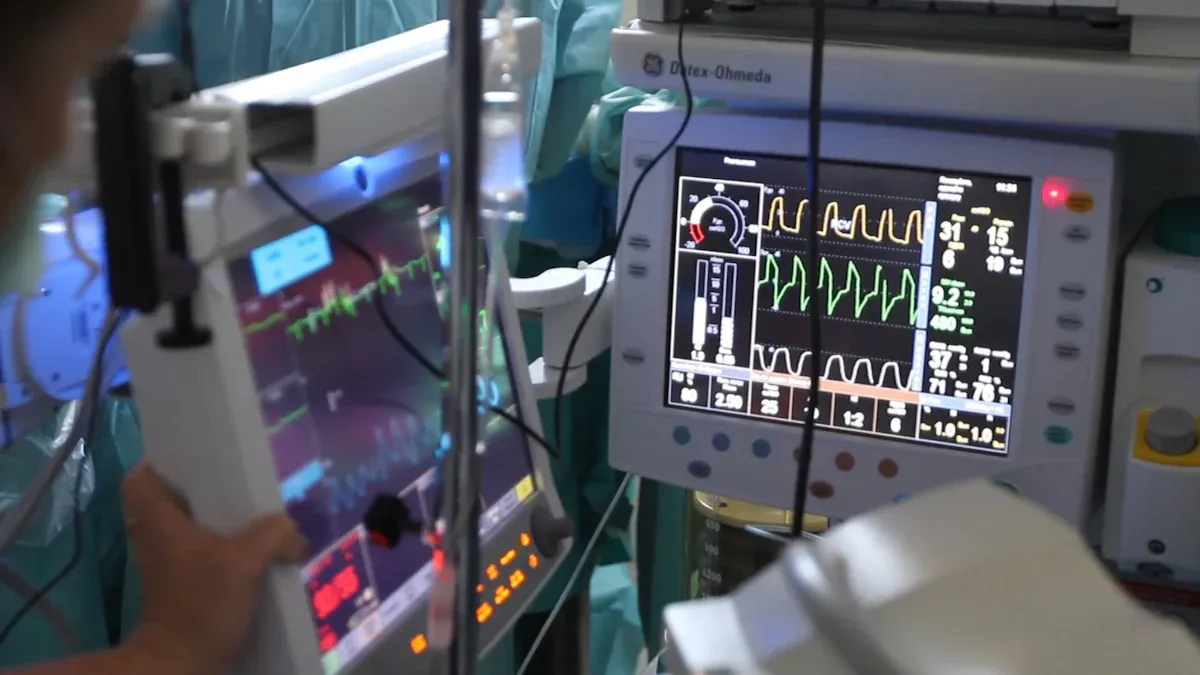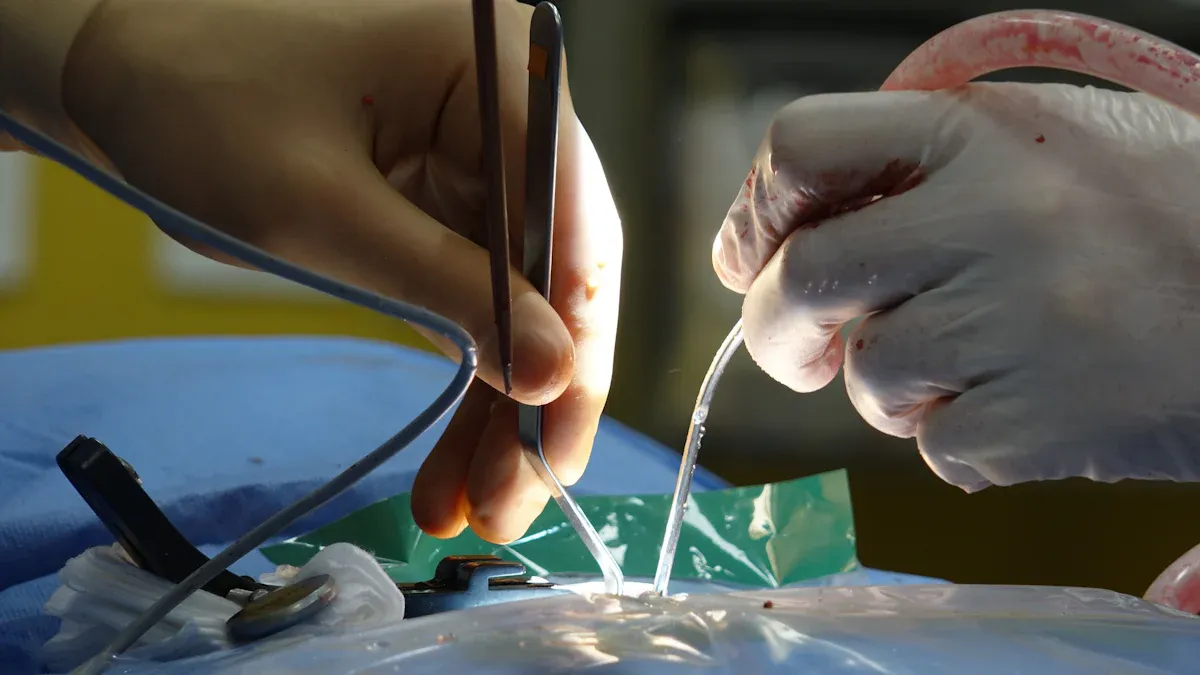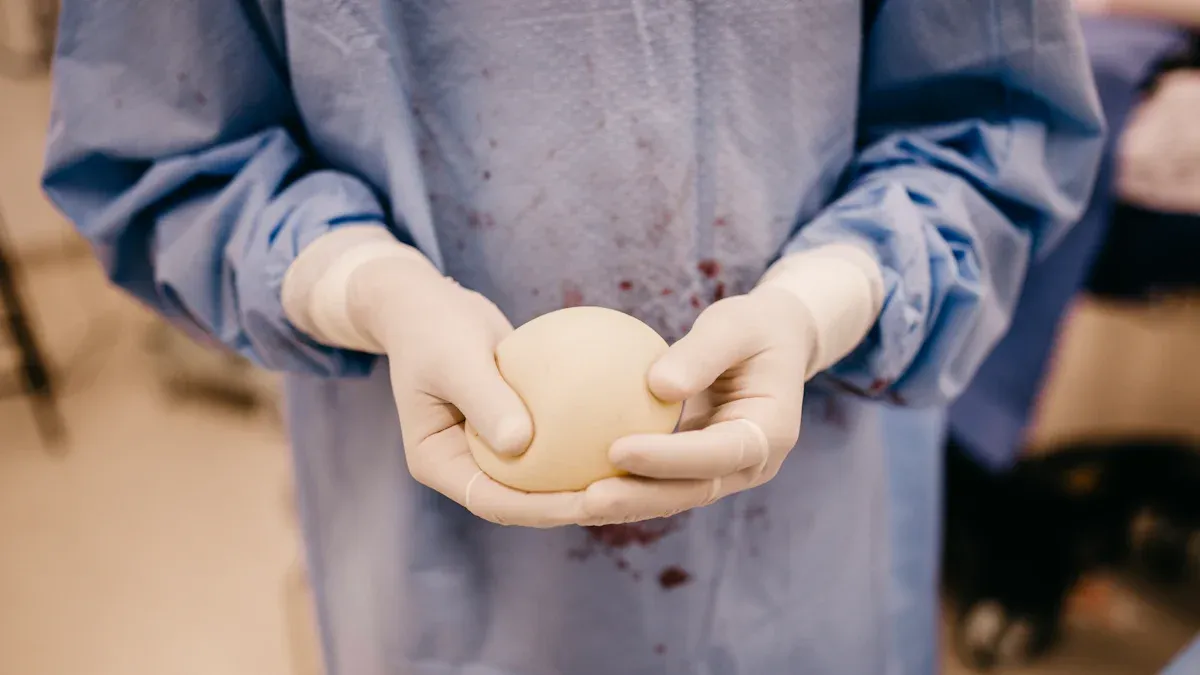How High-Strength Nitinol Tubing Transforms Vascular Stent Performance

High-strength Nitinol tubing is reshaping vascular stent technology with its remarkable properties. Its shape memory allows stents to expand to their intended size at body temperature, ensuring precise placement and improved blood flow. Superelasticity enables these stents to adapt to the body’s movements without losing form, enhancing arterial health. Studies reveal a 20% improvement in recovery rates and quicker healing times when using Nitinol-based devices. The material’s biocompatibility also minimizes complications, making it a trusted choice for minimally invasive procedures. High-strength Nitinol tubing for vascular stents OEM continues to drive these advancements, revolutionizing patient care.
Key Takeaways
Strong Nitinol tubing improves stents by expanding at body heat.
Nitinol stents bend easily, moving with the body to avoid issues.
Nitinol is safe for the body, causing fewer bad reactions.
Studies show Nitinol stents help patients heal 20% faster.
Careful design makes Nitinol stents fit medical needs perfectly.
What Is High-Strength Nitinol Tubing?
Defining Nitinol and Its Composition
High-strength Nitinol tubing is a specialized material composed of nickel and titanium, typically in a near-equiatomic ratio. This unique alloy derives its name from its components—Nickel (Ni) and Titanium (Ti)—and the laboratory where it was first developed, the Naval Ordnance Laboratory (NOL). The material’s composition is carefully controlled to achieve its remarkable properties, including shape memory and superelasticity. Advanced manufacturing processes ensure the tubing meets stringent medical standards, making it suitable for critical applications like vascular stents.
Note: The precise balance of nickel and titanium in Nitinol is crucial for achieving its transformative characteristics, such as biocompatibility and corrosion resistance.
Unique Properties: Shape Memory, Superelasticity, and Biocompatibility
High-strength Nitinol tubing stands out due to its extraordinary properties, which make it ideal for medical applications:
Shape Memory: Nitinol can "remember" its original shape. When compressed or deformed, it returns to its pre-set form upon exposure to body temperature. This feature ensures stents expand precisely within blood vessels, optimizing blood flow.
Superelasticity: The material can undergo significant deformation and recover over 90% of its shape without permanent damage. This property is essential for stents navigating complex vascular structures.
Biocompatibility: Nitinol minimizes adverse reactions, making it safe for long-term use in the human body. Its surface finish also enhances corrosion resistance, ensuring durability under clinical conditions.
Characteristic | Description |
|---|---|
Biocompatibility | High-strength Nitinol tubing minimizes the risk of adverse reactions, making it ideal for long-term implants like stents and guidewires. |
Corrosion Resistance | The surface finish of Nitinol tubing significantly affects its corrosion susceptibility, with advanced manufacturing techniques ensuring minimal surface flaws. |
Fatigue Strain Limits | Research indicates fatigue strain limits of 0.4–0.8%, showcasing the material's durability under clinical conditions. |
These properties collectively enable Nitinol tubing to outperform traditional materials like stainless steel and titanium alloys in vascular stent applications.
Applications of Nitinol in Medical Devices
The applications of Nitinol extend far beyond vascular stents, revolutionizing various medical devices. Its unique properties make it indispensable in minimally invasive procedures.
Vascular Stents: Nitinol stents adapt to dynamic environments, ensuring consistent support and reducing complications.
Guidewires: Superelasticity allows guidewires to navigate intricate vascular pathways without breaking.
Flow Diverters: Thin-film Nitinol flow diverters effectively reduce intra-aneurysmal flow, aiding in aneurysm treatment.
Study Title | Authors | Journal/Publication | Year | Description |
|---|---|---|---|---|
A Novel, Hyperelastic Thin Film Nitinol Neurovascular Flow Diversion Stent | Levi D.S., Kealey C.P., Chun Y.J., et al. | Journal of Neuroradiology | Submitted for review | Focuses on a new type of stent for neurovascular applications. |
Intra-Aneurysmal Flow Reductions in a Thin Film Nitinol Flow Diverter | Youngjae Chun, Soojung C. Hur, et al. | Smart Materials and Structures | Submitted for review | Examines flow reduction capabilities of a Nitinol flow diverter. |
Thin Film Nitinol Microstent for Aneurysm Occlusion | Youngjae Chun, Daniel S. Levi, et al. | Journal of Biomechanical Engineering - ASME Trans. | 2009 | Discusses a microstent designed for occluding aneurysms, highlighted on the journal cover. |
The versatility of Nitinol tubing continues to drive innovation in medical device design, improving patient outcomes and expanding the possibilities for minimally invasive treatments.
Benefits of High-Strength Nitinol Tubing for Vascular Stents

Enhanced Durability for Long-Term Use
High-strength Nitinol tubing offers unmatched durability, making it ideal for vascular stents designed for long-term use. Its ability to withstand mechanical stress ensures stents maintain their structural integrity over time. Nitinol self-expanding stents demonstrate a favorable expansion profile, reducing acute arterial injury compared to balloon-expandable stents. Moderate vessel remodeling and diminished neointimal growth further highlight the material’s resilience.
Note: Clinical studies involving 30 sheep implanted with iliac vein stents revealed no damage or fractures immediately after implantation, showcasing the reliability of Nitinol-based stents.
Analysis Type | Description |
|---|---|
Inflammation Score | Calculated based on leukocyte counts in high-powered fields across different stent sections. |
Statistical Methods | ANOVA and t-test for group comparisons; Kruskal–Wallis test for inflammation score. |
Significance Level | p < 0.05 considered statistically significant. |
These findings underscore the advantages of Nitinol stents in minimizing complications and ensuring long-term performance.
Superior Flexibility for Adapting to Complex Anatomies
Nitinol tubing excels in flexibility, allowing vascular stents to adapt to intricate anatomical pathways. This property is crucial for stents navigating tortuous vascular structures without causing vessel injury. Precision manufacturing techniques enhance the tubing’s flexibility and durability, enabling it to withstand mechanical stresses in challenging environments.
Feature | Benefit |
|---|---|
Strength-Flexibility Balance | Essential for navigating complex vascular pathways. |
Superior Flexibility | Enhances performance compared to other alloys. |
Mechanical Stress Resistance | Ensures durability in intricate pathways. |
The flexibility for complex anatomies provided by Nitinol stents ensures optimal placement and reduces the risk of complications during minimally invasive procedures.
Improved Patient Outcomes Through Biocompatibility
Nitinol’s biocompatibility plays a pivotal role in improving patient outcomes. Its compatibility with human tissue minimizes adverse reactions, reducing inflammation and the risk of rejection. The material’s elasticity enhances the performance of stents, enabling less invasive procedures that prioritize patient comfort.
Nitinol stents navigate complex anatomical pathways with minimal disruption to surrounding tissues, reducing trauma during procedures.
Faster recovery times and improved patient experiences result from the material’s ability to minimize inflammation and rejection.
Clinical studies confirm that Nitinol-based stents lead to better long-term outcomes, making them a preferred choice for vascular applications.
Tip: Nitinol’s biocompatibility ensures safer and more effective stent designs, transforming patient care in minimally invasive treatments.
The advantages of Nitinol stents extend beyond durability and flexibility, offering significant improvements in patient safety and recovery.
Nitinol Stent Manufacturing and Its Advantages

Precision Engineering for High-Quality Stents
Nitinol stent manufacturing relies on precision engineering to produce high-quality stents that meet stringent medical standards. Advanced manufacturing techniques ensure precise control over the composition and microstructure of Nitinol tubing. This level of precision allows manufacturers to tailor stents to specific anatomical and clinical needs, enhancing their performance and patient outcomes. Adjustments to dimensions, wall thickness, and mechanical properties enable the creation of stents optimized for various applications, including drug-eluting stents that require consistent drug delivery.
AccuPath employs cutting-edge technology to produce Nitinol tubing with superior surface finishes, reducing the risk of corrosion and improving biocompatibility. Studies show that better surface finishes increase breakdown potentials and minimize surface inclusions, which can initiate corrosion pits. This focus on quality control in nitinol stent production ensures reliable and durable stents for long-term use.
Evidence | Description |
|---|---|
Improved surface finishes enhance the corrosion resistance of Nitinol stents. | |
Breakdown Potentials | Longer immersion times increase breakdown potentials, depending on the surface finish. |
Surface Inclusions | High-quality finishes reduce surface inclusions, improving overall durability. |
Cost-Effectiveness in Large-Scale Production
Nitinol stent manufacturing achieves cost-effectiveness through innovative production methods. Laser cutting technology plays a pivotal role in reducing production time and material waste. This method eliminates the need for multiple machining steps, allowing for precise cuts in a single operation. The non-contact nature of laser cutting minimizes downtime and maintenance, further improving efficiency. Studies indicate that production rates can increase by up to 30%, making it an ideal choice for large-scale manufacturing.
Manufacturers benefit from the ability to produce Nitinol tubing in a wide range of dimensions, from outer diameters as small as 0.1mm to as large as 12mm, with wall thicknesses as thin as 0.05mm. This versatility supports the creation of stents for diverse applications while maintaining cost efficiency.
Tip: Laser cutting not only enhances precision but also reduces operational costs, making it a preferred method in nitinol stent manufacturing.
AccuPath: A Leader in High-Strength Nitinol Tubing for Vascular Stents OEM
AccuPath stands out as a leader in supplying high-strength Nitinol tubing for vascular stents OEM operations. The company’s commitment to quality control in nitinol stent production ensures stents meet the highest standards of durability and biocompatibility. AccuPath customizes transformation temperatures between -100°C and +100°C based on application needs, enabling stents to perform optimally in diverse clinical environments.
AccuPath’s manufacturing capabilities include producing tubes with precise dimensions and wall thicknesses, tailored to specific anatomical requirements. This customization enhances stent performance and improves patient outcomes. Drug-eluting stents benefit from AccuPath’s ability to maintain consistent tubing dimensions, ensuring effective drug delivery.
Evidence Description | Findings |
|---|---|
Importance of surface finish to corrosion susceptibility | Evaluated nitinol stents with different surface finishes, indicating varying corrosion resistance. |
Corrosion effects on biocompatibility | Corrosion impacts biocompatibility assessments, highlighting the need for extensive testing standards. |
Pitting corrosion initiation | Investigated surface flaws and inclusions as potential sites for corrosion pit initiation, affecting corrosion resistance. |
AccuPath’s dedication to innovation and precision makes it a trusted partner for OEMs seeking high-quality Nitinol tubing for vascular stents.
Why Nitinol Outperforms Other Materials in Stent Applications
Comparison with Stainless Steel: Flexibility and Biocompatibility
Nitinol surpasses stainless steel in flexibility and biocompatibility, making it a preferred material for vascular stents. Stainless steel stents often struggle to adapt to the dynamic movements of blood vessels, leading to potential complications. Nitinol’s superelasticity allows it to bend and recover without permanent deformation, ensuring stents maintain their shape even in complex anatomical pathways.
Biocompatibility is another area where Nitinol excels. Stainless steel stents may cause adverse reactions due to their composition, while Nitinol minimizes inflammation and rejection. Its corrosion resistance further enhances its suitability for long-term medical implants. These attributes make Nitinol tubing a reliable choice for stent applications, improving patient safety and outcomes.
Comparison with Cobalt-Chromium: Durability and Shape Memory
Nitinol outperforms cobalt-chromium in durability and shape memory, two critical factors in stent performance. Cobalt-chromium stents offer high strength but lack the ability to recover their original shape after deformation. Nitinol’s shape memory effect ensures stents expand precisely within blood vessels, optimizing blood flow and reducing complications.
Tests such as Differential Scanning Calorimeter (DSC) and Bend Free Recovery (BFR) confirm Nitinol’s superior shape recovery capabilities. These tests adhere to ASTM standards, ensuring the reliability of Nitinol tubing production. Comparative studies highlight Nitinol stents, like the Supera interwoven stent, as having lower rates of target vessel revascularization compared to bare nitinol stents. This demonstrates Nitinol’s ability to maintain its performance over time.
Property | Description |
|---|---|
Shape Memory Effect | Recovers its original shape when heated above its transformation temperature. |
Superelasticity | Returns to its original shape after deformation without permanent damage. |
Corrosion Resistance | Resists corrosion, enhancing longevity in medical and industrial applications. |
Nitinol’s durability and shape memory make it a superior choice for stent applications, ensuring long-term reliability and effectiveness.
Long-Term Benefits of Nitinol in Vascular Stents
Nitinol offers significant long-term benefits in vascular stent applications. Its ability to adapt to dynamic environments reduces the risk of complications, ensuring consistent support for blood vessels. The material’s corrosion resistance enhances its longevity, making it ideal for medical implants that require durability.
Clinical studies confirm that Nitinol-based stents improve patient outcomes by minimizing inflammation and rejection. Faster recovery times and reduced need for revascularization highlight the material’s effectiveness. Nitinol’s unique properties, including shape memory and superelasticity, enable stents to perform optimally in diverse clinical scenarios.
Tip: Nitinol’s long-term benefits make it a trusted material for stent applications, transforming patient care in minimally invasive treatments.
The combination of flexibility, durability, and biocompatibility ensures Nitinol remains unmatched in vascular stent performance, setting a new standard in medical device design.
High-strength Nitinol tubing for vascular stents OEM has revolutionized the design and performance of medical devices. Its unmatched durability, flexibility, and biocompatibility ensure superior outcomes in vascular stent applications. The material’s shape memory alloy properties allow stents to adapt seamlessly to complex anatomies, enhancing patient safety and recovery.
A comparison of key performance indicators highlights Nitinol’s advantages over other materials:
Property | Nitinol | Stainless Steel | Titanium |
|---|---|---|---|
Tensile Strength | 550-900 MPa | 480-2000 MPa | 350-900 MPa |
Yield Strength | 200-500 MPa | 250-1700 MPa | 275-800 MPa |
Elongation | 10-15% | 40-50% | 10-20% |
Corrosion Resistance | Excellent | Good | Excellent |
Fatigue Strength | Moderate | Good | Excellent |
Biocompatibility | Excellent | Good | Excellent |
AccuPath continues to lead innovation in high-strength Nitinol tubing for vascular stents OEM, delivering medical devices with exceptional biocompatibility and corrosion resistance. This commitment ensures enhanced patient safety and sets a new standard in medical device performance.
FAQ
What makes nitinol ideal for vascular stents?
Nitinol offers shape memory and superelasticity, allowing stents to adapt to dynamic environments. Its biocompatibility minimizes adverse reactions, ensuring safer long-term use in the human body.
How does nitinol improve patient outcomes?
Nitinol stents reduce inflammation and rejection risks. Their flexibility ensures precise placement, minimizing trauma during procedures and promoting faster recovery.
Are nitinol stents durable?
Nitinol stents resist corrosion and maintain structural integrity under mechanical stress. Clinical studies confirm their reliability for long-term use in vascular applications.
How is nitinol tubing manufactured for stents?
Manufacturers use precision engineering to control nitinol’s composition and microstructure. Techniques like laser cutting ensure high-quality stents tailored to specific clinical needs.
Why does nitinol outperform other materials in stent applications?
Nitinol surpasses stainless steel and cobalt-chromium in flexibility, durability, and shape memory. Its unique properties ensure optimal performance in complex anatomical pathways.
See Also
Nitinol Tubing: A Game Changer for Medical Devices
Nitinol Tubing's Contribution to Medical Technology Progress
Nitinol Tubing Versus Stainless Steel: A Strength Comparison

